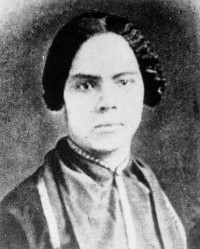Honoring Mary Ann Shadd Cary
Journalist and activist Mary Ann Shadd Cary may not be a household name today, but her work made a significant impact on our country. In celebration of Black History Month, join us in learning more about this groundbreaking abolitionist and suffragist.
Shadd Cary’s accomplishments were recently highlighted in an obituary in The New York Times’ “Overlooked” series: “Shadd Cary was the first Black woman in North America to edit and publish a newspaper, one of the first Black female lawyers in the United States and an advocate for granting women the right to vote.”
Shadd Cary’s social justice and activist roots began with her abolitionist parents, who often provided lodging for fugitive slaves in their home in the 1820s. Shadd Cary lived in Delaware until she was about 10. Then her family moved to Pennsylvania because Black children were not allowed to be educated in Delaware.
Shadd Cary completed her schooling and became a teacher. in 1850, When Congress passed the Fugitive Slave Act in 1850 — requiring law enforcement and ordinary citizens to help capture runaway slaves, and penalizing those who did not comply — she moved to Canada.
In Ontario, Shadd Cary provided education and support to the growing population of freedom seekers crossing the border. In 1853, she founded The Provincial Freeman, Canada’s first antislavery newspaper.
Her pioneering journalism was too progressive for her critics, who disagreed with her call for full racial integration, rather than segregated schools and communities. Undeterred by those of limited imagination, Shadd Cary traveled to the United States to promote her newspaper and its message of full citizenship for Black Americans. The Provincial Freeman ceased publication due to financial difficulties by 1860, but Shadd Cary continued working as an advocate for equality, teaching at an integrated school.
When the Civil War began in 1861, Shadd Cary returned to the United States to assist in the war effort. As a recruiting officer for the Union Army, she encouraged Black men to join up and fight against the Confederacy.
After the war, Shadd Cary attended Howard University. She became the second African-American woman in the United States to earn a law degree, and she used her skills to champion the women’s suffrage movement.
She addressed a House Judiciary Committee as part of a group of women petitioning for the right to vote in 1874. Though it took many more decades for women to win the right to vote, Shadd Cary’s tireless work to realize the American democratic dream made a lasting impact on every movement she touched.
The biography “Mary Ann Shadd Cary: The Black Press and Protest in the Nineteenth Century” highlights Shadd Cary’s visionary contributions. Author and professor Jane Rhodes noted: “She was an active participant in many of the social and political movements that influenced the nineteenth century — abolition, black emigration and nationalism, women’s rights and temperance. … Her life offers a window on the free black experience, emergent black nationalisms, African-American gender ideologies, and the formation of a black public sphere.”
Shadd Cary was a trailblazer in the legal profession and beyond, and we’re honored to pay tribute to her important work.

